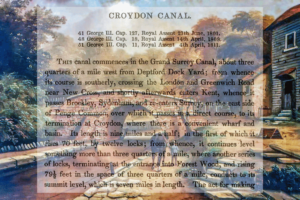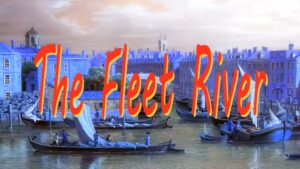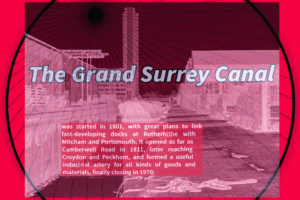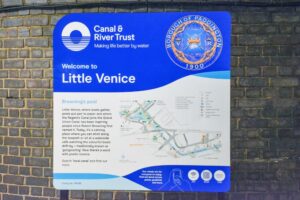The Great Central Railway depot at Lisson Grove (Marylebone)
Very litte is mentioned about this important part of Marylebone’s history. The Great Central Railway Company built its new rail facility (usually known as Marylebone Goods Terminus) and it opened on April 10th 1899, some weeks after the main passenger terminus. It was a large terminus on an east-west alignment sited between Park Road and Penton Street. It had a facility for loading and unloading goods to and from canal boats at what is now known as the Lisson Grove moorings (otherwise called Marylebone Wide)
The construction of both the main lines into Marylebone and the goods terminus neccesitated the demolition of the splendid Nash houses on North and South Bank, either side of the Regents Canal at Marylebone Wide. A substantial portion of the 51 acres required, the squalid and crowded homes of 4,448 of the ‘labouring class’ were demolished. A photograph of the new railway bridge to the goods yard is shown here and further works such as a steam powered crane near the canal, a crane at the construction of the depot
It is often said that Crocker’s Folly was built to serve a possible new railway terminus at Marylebone. The story goes that the terminus was built further to the south. In some ways this story is not completely true because Crocker’s Folly did serve the Great Central Railway’s depot, although the depot workers that used the inn were not quite as high-class as the hoped for passengers in Frank Crocker’s original scheme

Old map showing the depot at Lisson Grove, with Marylebone station, Lords and the canal
In addition to the Marylebone Goods Terminal, there was also what was known as Marylebone yard, on the west side of the station area. This consisted of the stabling sidings for locomotives and carriages, as well as a small goods depot whose frontage faced onto Rossmore Road. When marylebone’s status was reduced the stabling sidings were transferred to the east side where they remained for the use and servicing of the Aylesbury and Banbury surburban services. In recent years the land for this was sold off for flats and the western side partially restored for stabling purposes. A turntable was sited just by Rossmore Road bridge and this was one of the last old features to remain of the former western yard, being used for steam specials until the 1990’s

The site of Marylebone’s turntable by Rossmore Rd (at bottom)
At one time there were at least three railway bridges across the Regents Canal belonging to the Great Central. These carried a total of fourteen railway tracks. A fourth crossing slightly to the east was for the Metropolitan Railway. The most western most tracks crossed the canal at an angle to the other three, basically on a south-western axis about where Pateley Street footbridge stands today. These tracks provided rail access to the good depot. There is an extra span on the north side of the canal that is used by walkers along the canal. The next section examines the interesting history behind this extra span
Abortive railway and monorail schemes
The northern, smaller bridge span, does not at first sight appear to have been built for any reason. It is generally used as an alternative route to the towpath between Pateley Street footbridge and the canal access steps to Park Road. Its origin actually began in what could be termed some of the most obscure railway schemes ever to be planned in London, including, of all surprises, a monorail system. Despite the construction of canals all over the country during the 18th and 19th Century, the presence of the railways were soon felt. This caused much consternation for the canal companies and their slow moving canal barges. Some of the country’s canals ended up being sold off for conversion into railways. The London area had several examples of this, the best known being the Croydon Canal. Naturally some canal companies sought to quell the threat of competition by becoming railway operators themselves
In the light of the railway competition, the Regents Canal company decided to either convert its canal to a railway or at least provide a railway route alongside. It formed a new company with a view to implementing its proposals. This new venture was known as The Regents Canal, City and Docks Railway. From a bunch of various proposals concieved, the biggest seems to have been for a 16 mile route from the Great Western at Royal Oak, alongside the Regents Canal to Limehouse, and thence to the Royal Albert Docks. This railway was authorised by an act of 1882. When the Great central Railway’s London extension was being built, a request was made for the provision of an extra span at Lisson Green. This was to enable the Regents Canal’s proposed railway to pass through should it be built. The unused span is shown in the picture below
In 1887 the company sought an extension to its initial act of 1882 to give it more time to plan and execute its railway schemes, as well as to permit the powers to build underneath the GCR at Lisson Green. One possible reason for the delay of the canal’s railway schemes is likely to have been finance. The canal company soon dropped its schemes to build a network of railways, and it sought a further act in 1892, which renamed it the Regents Canal & Dock Co. As events show, this latter company survived to become the Grand Union Canal Company in 1928, successfully owning a large network of canals
Following the failure of the Regents Canal’s aspirations for a railway network of its own, the unused span at Lisson Green later saw a possible new use. This was a scheme planned by Fritz Bernhard Behr, managing director of the Listowel and Balybunion Railway, and chief engineer to Lartique. Behr’s intended to build a monorail system by the Regents Canal in 1903, carrying both passenger and freight. I suspect this would have worked at a far more sedate speed compared to Behr’s earlier scheme for a 120mph Monorail Express Railway from Liverpool to Manchester! Note: Behr’s scheme was for a monorail along the waterway, not above it like the Wuppertaler Schwebebahn.

The unusued span at Lisson Green, destined for abortive railways such as F.H. Behr’s North Metropolitan & Regents Canal monorail system
More about the goods terminal and a couple of videos. The Marylebone Goods Terminus was controlled by one of the largest signal boxes on the Great Central Railway. Goods junction box had capacity for 100 levers and controlled the junction from the Great Central’s main line into Marylebone goods terminus. It also oversaw the country’s first semi-automatic three aspect colour light signalling system, designed to enable trains running with just three minute headways between Marylebone and Wembley
There seems to be very few pictures of the Marylebone goods terminus. There’s one featured at the west side entrance to Marylebone station itself, picture shown below. Its not a brilliant one because of glares from lighting. If one looks carefully might find the station’s modern led train indicator’s reflection in the middle right of the picture! The information accompanying the picture tells us that the GCR invested in large cranes whose capacity was 25 tons. It also mentiones the special wharf built to allow transhipment of ‘coal and other merchandise’ into canal barges. A colour photo of what is possibly an original GCR coach at the depot from Ron Fisher’s collection is about the only other one I can find
Leicestershire County Council have an excellent porfolio of images on the Great Central Railway’s construction, and several of these feature the construction of the Marylebone goods and passenger terminals, as well as the bridges across the Regents Canal. Several of these images have direct links at the top of the page in the text within the first three paragraphs of this feature
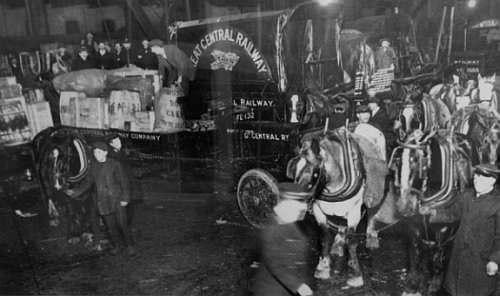
The depot had a southern extension whose frontage was on the corner of Lisson Grove and Rossmore Road. Although I cant find any pictures of this part of the complex, there are these videos:
MECHANICAL COAL HANDLING: MARYLEBONE
Video showing a new mechanical coal handling system at Marylebone good yard in 1963, with views of the archway leading onto Lisson Grove
RAILWAY EXHIBITION: MARYLEBONE
This shows the 1961 railway exhibition at Marylebone goods yard in 1961. The Evening Star and Mallard are the engines on view under the banner proclaiming ’50th Anniversary’
The depot closed in 1965 as part of Beeching’s cuts. These saw the entire GCR route from both Calvert and Gretton Underwood junction to Annesley in Nottinghamshire shut down completely by 1966. The railway route into Marylebone ceased to function as a main line, being relegated to surburban workings for Aylesbury and High Wycombe/Banbury. Of course times have changed and Marylebone now sees longer distance workings to Birmingham, Kidderminster and Wrexham. There doesnt seem to be any record of when the railway bridge across the canal to the goods terminal was removed, but I expect it was sometime in the seventies before Westminster City Council began work on the construction of the Lisson Green estate
Mention must be made of Melbury House. The address: British Waterways Board, Melbury House, Melbury Terrace, London NW1 6J, will ring a bell to many older canallers. It was the main headquarters for BWB for many years and was sited in the part of Marylebone station that was to hold six extra platforms in anticipation of a busier future role. This of course never happened and the vacant platform area became Melbury House. To some it was known as ‘Melburyland.’ The WRG often declared its office marquee at the popular ‘Big Digs’ of the seventies and eighties ‘Melburyland,’ becoming the source of many a joke amongst the wergies. Enuf said – BWB/Melbury House has been discussed elsewhere on London Canals
The Goods Terminal site today
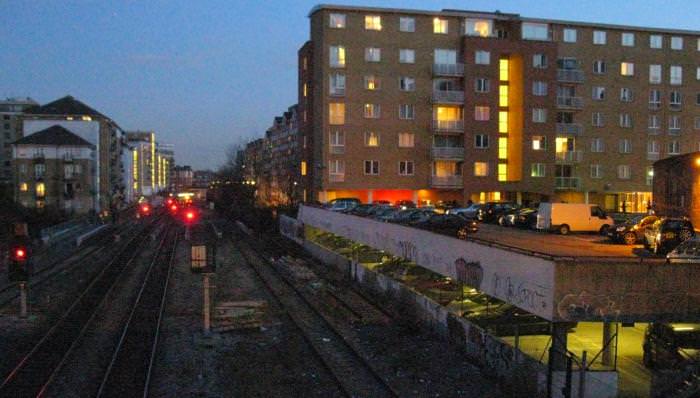
A view of the railway lines from Lodge Road bridge. The immediate foreground is where the lines for the Marylebone Goods Terminal once diverged to the right. Its route is now occupied by the car park and the large block of flats. The canal is where the pairs of red signals are

The Regents Canal from Pateley St footbridge in Lisson Green. Marylebone Wide is in the distance. This was where the GCR had a wharf for loading into boats
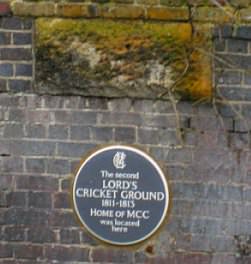

Between Pateley St and the railway are plaques identifying the location of the second Lord’s cricket ground
Above the plaques are the large stone blocks set into the wall at intervals that formed the base of the former goods terminal bridge over the canal. The right hand picture looks across the canal to the Lisson Green estate at the angle the railway would have entered the goods terminal
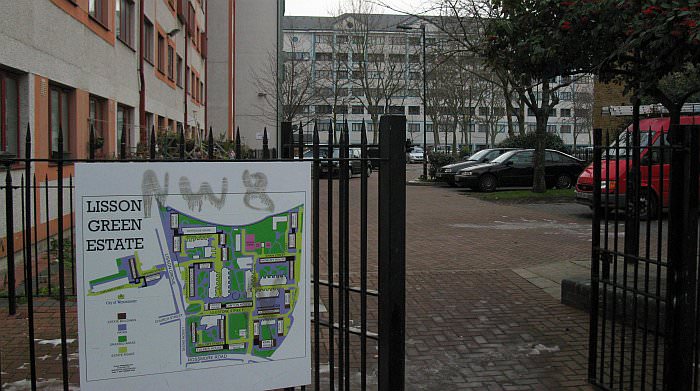
The Lisson Green entrance by Pateley St footbridge. The rail tracks would have curved right to align with the present Grendon St, shown below
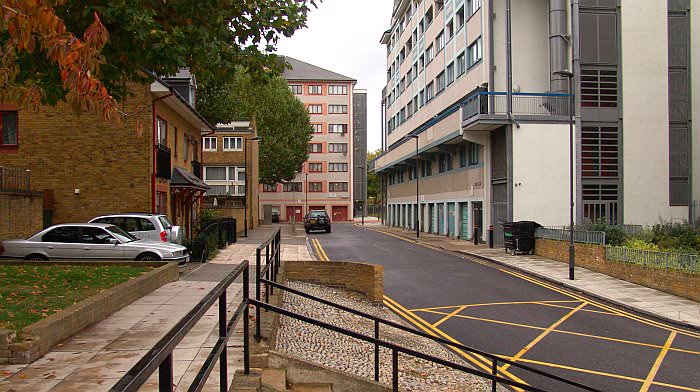
The old railway alignment looking back from Lisson Grove bridge along Grendon Street towards Regents Canal

Lisson Grove railway bridge still exists. The road height gauge shows it was once used by estate traffic
There are several remains of the Great Central’s goods depot. The largest and most obvious is perhaps the retaining wall along the side of Luton and Penfold Streets, which bordered the depot. The depot itself sat in a hollow and at the Penfold St end the main access ramp that led down to the depot still exists, serving the flats that now stand on site. Lisson Grove itself has another reminder of the depot. There is a slight rise in the road to the south of the canal, and this is the site of a overbridge that once straddled the railway lines. if one goes down to lower street level at what is Grendon Street, a good view of the bridge itself can be seen. Until recently it used to serve as a road access between the two sides of the Lisson Grove estate but its now blocked off. The name Grendon Street, is another clue to the old depot. Grendon was one of the places served on the Great Central railway’s route

View from the top of the Lisson Grove bridge onto the former GCR depot site. This is now Capland Street

In Luton Street, looking along the old GCR Company’s wall towards Penfold Street. The Spitfire Works are at the far end
Abbey – The famous road, crossing, studios & The Beatles
Bayswater – Shops in West London a short distance from Little Venice
Camden – The Horse Market & tunnels
Crockers – The large folly pub atop Maida Hill Tunnel
Derry/Toms – Kensington’s famous 1930’s roof gardens
Edgware Rd – Watling Street: One of London’s oldest thoroughfares
Great Central – A large railway depot at Marylebone/Lisson Grove
Metesco – A little-known electricity sub-station near the canal
Nash Houses 1 – Old and modern versions alongside the canal
Nash Houses 2– North, South Bank & Park Villages
Aircraft Factory – The unique Spitfire buildings in W2
St. Pancras – London’s International Rail Terminus
